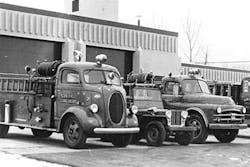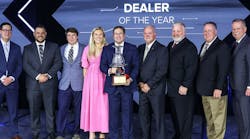A while ago, I wrote a blog about my fire department starting a truck committee and now we’re two meetings in and we’ve already met with a vendor. The move is working for us, even though it may not have been the recommended path from everything I’ve heard.
It did, however, focus us a bit and we’re now heading down the path toward a new engine within the next couple of years. Hopefully, we’ll get it built before the 2017 Environmental Protection Agency (EPA) emission standards come in to play.
Our first meeting went fine, we discussed the pros and cons about custom cabs and chassis versus commercial vehicles. There was no debate their as everyone on the committee wants a custom cab for the personnel, the room and the generally excepted better reliability.
We’ve also agreed on our pump size 1,500 gpm, but we’re having a debate on tank size and number of axles. It’s a good healthy debate and I know we’ll come up with the right answers
For various reasons, we talked about a 2,500-gallon pumper tanker with tandem axles. Personally, I think that’s too big. The pumper it will replace has a 1,000-gallon tank. The catch is that we’ll be retiring a 1,800-gallon tanker when we take delivery of our replacement pumper.
There are so many factors to consider. One of the biggest is a sizeable percentage of our immediate coverage area has a reasonably good hydrant system that will handle all but the biggest fires – and who has big fires these days in small rural communities. I know, I’ve jinxed myself, but I’m just saying.
Another factor is in 2003, we purchased a 1,800-gallon tanker that was supposed to be the replacement of the 1983 gasoline-driven unit with hydraulic over electric brakes, a stick shift and an electric two-speed axle. We kept it because our district was going through some improvements to the municipal water system and it was just a precaution to keep some additional water on wheels. That work has since been completed.
Another factor is a neighboring community just a few miles to our north just took delivery of a 3,000-gallon tanker and they’re on our first due assignment for any structure fires or any significance. I’d rather let them haul the water for us.
My thought is a compromise would be 1,500-gallons. I am not adverse to a tandem axle truck, but I’d like to see a lot more compartment and storage space than water. One of the biggest hassles with our current front-line engine is there’s too much stuff on it. It is difficult to find things and access stuff, even when you know where it’s all supposed to be. I am not complaining too loudly, our taxpayers have been extremely supportive over the years and we’ve got a lot of equipment for a small fire department. We now need something more appropriate to haul it all to the scene.
I should say we respond to about 100 runs a year, with 50 to 60 percent of those being medical calls. And, knock wood, we’ve haven’t had a structure fire in our district in over two years. We’ve helped out with a number of others on mutual aid runs, but we’ve been very fortunate to have a low run volume.
We have a number of taxpayers in our community who believe they are experts on trucks and believe they know what we need for fire apparatus. Our specifications will be scrutinized extensively and we’ll have to justify just about everything on the apparatus – including the number of gallons of water we’ll carry.
The target of 1,500 gallons, or so, seems to be gaining acceptance in the committee, but we’ll see how things go as we get further into the process.
Body material is also being discussed. Most on the committee want a stainless steel body, and that’s not a problem for the most part. Stainless steel is more expensive and heavier than aluminum and manufacturers have gone a long way with the durability, corrosion resistance and strength of aluminum-bodied apparatus. A few are even offering life-time warranties. Our 2003 tanker has an aluminum body and we have not had any problems with it to date.
For us in Northern New England, stainless steel make some sense. Roads are heavily treated with salt and a few places use calcium chloride which is even more corrosive than salt. We’ll need to give some serious thought about body material type and do some cost benefit analysis regarding stainless versus aluminum.
Our second meeting included an apparatus sales representative. I have attended classes at conferences at Firehouse Expo and Firehouse World and other venues where instructors have cautioned about bringing in a sales representative too soon. In fact the one that was sitting with us at our second meeting was very pleased to have been included so early in the process. The company he represents makes fine apparatus and I am sure we’d be very happy with anything we bought from that company. However, from what I have gleaned over the years, it’s better to keep specifications open and generic to get the best deal for the community and the taxpayers who are paying for the apparatus.
We made it perfectly clear that we were very early in the discussion stage and there were no guarantees we’d purchase anything from him. With the ground rules set, he helped the committee focus a little bit on the kinds of things we need for our apparatus. As it turns out, everything we may be specifying is fairly common and generic.
From that list of items, I hope we can develop a needs and want list that will help us stay on task and on budget. We really do not have a set figure in mind, but we do need to be aware that whatever we ask for will be reviewed by a new, town-wide committee and we’ll have to have solid rationale for the specification. Just for an example, we might want a Roto-Ray, but we may not be able to justify it. We’ve had one town official already say he wouldn’t approve “a half a million dollar toy” for our department. We’re not going for that anyway, so we should be set.
Now that we’ve already gone down the road of talking to vendors and sales representatives, I think we ought to invite others in for some general discussions too – just to see what others are offering.
I’ll be the first to admit that we’re pretty isolated and remote in northern New Hampshire. It’s not often that apparatus is delivered anywhere near us, so it’s challenging to get gander at what’s out there.
That’s why we’re all planning to go to the New England Chiefs Association conference and show in Springfield, Mass. in June.
Attending shows is a terrific way of seeing a lot of different apparatus all at one place with knowledgeable people at the ready to answer questions and point out features. I’d like to have one more meeting before we actually go to come up with a very preliminary set of specifications so we have some focus on what kinds of things to look for.
Perhaps some of us can make to Baltimore for Firehouse Expo in July to see a few more and get additional information.
I can’t think of a better way to get educated on just what’s out there and what it can do for your department.
- At Firehouse Expo in Baltimore - Several programs for fire apparatus design and purchasing are being featured at Firehouse Expo, July 15-19, in Baltimore. Classroom sessions include "Out of Shape and Overweight -- How to Size Up Your Apparatus Fleet?" and "Initial Response Apparatus-What Size Vehicle is Right for Your Department" by Tom Shand and Michael Wilbur. The conference also features a special program just for fire apparatus mechanics.






